语法专项讲解
高考英语不定式专项语法讲解

eg.1: It is not difficult for us to learn English well.
例如:difficult, wonderful, meaningful, painful, useful
(2) 作宾语 Would you like to watch TV?
She is too anxious (ready/easy/eager/glad) to
know the results. 肯定
不定式中作结果状语的注意点:
1)某些形容词在“too…to…”结构中表示 肯定,这类词是: anxious, eager, glad, ready, surprised, willing…
He cannot but move to another street.
We cannot help but admire his courage.
He always prefers to ride a bicycle rather than ride on a crowded bus.
(3) 作表语(表将来时)
②have, let, make三个使役动词后的省略
I made him stand outside. He was made to ...
这两类省略的不定式一旦变成被动语态,不 定式要补充完整.
动词不定式作宾补省略to
口诀 不定式省to十一个, 五“看”二“听”一“感
觉”, 三个“使役”紧挨着, 如若主动变被动, 符号to千万别省略。
不定式的逻辑主语: of(品质) / for (性质) sb. to do
语法专项讲解-非谓语动词

动词不定式: 动词不定式 to do
• We are willing to offer them what we had. • be willing to • They left early in the morning to catch the first train. • -以便、为了(目的) 以便、为了(目的) 以便 • I hurried back to the classroom only to find my wallet gone. • -结果 结果 • The classroom is too small to hold forty-five students. • too … to … 太…而不能 而不能… 而不能
动词不定式: 动词不定式 to do
• I prefer to live in the country rather than in a city. • prefer to do • The doctor advised him to take a rest. • advise sb. to do sth. • Have you decided where to hold the party? • They are discussing how to solve the problems. • wh- to do (where/ when / how /what …)
非谓语动词
广东轻工职业技术学院 钟岚
非谓语动词形式
• 动词不定式 to do 动词不定式: • 动名词 -ing 动名词: • 分词: -ing / -ed 分词
动词不定式: 动词不定式 to do
• It is important for us to learn English well. • It is + adj. (for sb.) to do sth. • (某人)做某事很 的。 某人)做某事很…的 • 注意:此处的形容词通常为对所做事情的描述, 注意:此处的形容词通常为对所做事情的描述, 重要的, 必要的, 如important重要的,necessary必要的, 重要的 必要的 difficult困难的,easy容易的,impossible不可 困难的, 容易的, 困难的 容易的 不可 能的等等。 能的等等。 • His plan is to finish the work in two weeks. • … is / are to do sth. …是要做某事 是要做某事
高中英语语法专项精讲-非谓语动词讲解
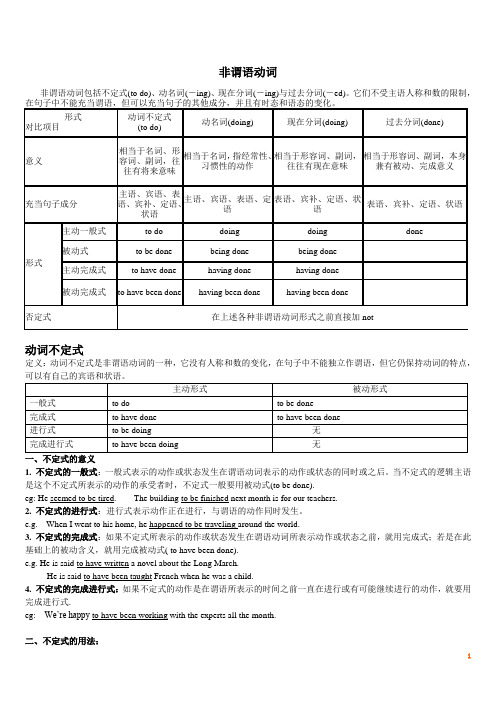
非谓语动词非谓语动词包括不定式(to do)、动名词(-ing)、现在分词(-ing)与过去分词(-ed)。
它们不受主语人称和数的限制,动词不定式定义:动词不定式是非谓语动词的一种,它没有人称和数的变化,在句子中不能独立作谓语,但它仍保持动词的特点,一、不定式的意义1. 不定式的一般式:一般式表示的动作或状态发生在谓语动词表示的动作或状态的同时或之后。
当不定式的逻辑主语是这个不定式所表示的动作的承受者时,不定式一般要用被动式(to be done).eg: He seemed to be tired. The building to be finished next month is for our teachers.2. 不定式的进行式:进行式表示动作正在进行,与谓语的动作同时发生。
e.g. When I went to his home, he happened to be traveling around the world.3. 不定式的完成式:如果不定式所表示的动作或状态发生在谓语动词所表示动作或状态之前,就用完成式;若是在此基础上的被动含义,就用完成被动式( to have been done).e.g. He is said to have written a novel about the Long March.He is said to have been taught French when he was a child.4. 不定式的完成进行式:如果不定式的动作是在谓语所表示的时间之前一直在进行或有可能继续进行的动作,就要用完成进行式.eg: We’re happy to have been working with the experts all the month.二、不定式的用法:1. 不定式做主语:不定式做主语一般表示具体的某次动作。
而动名词doing 表示习惯的,经常的动作。
人教版高三英语语法专题讲解--非谓语动词

语法专项训练(九)——非谓语动词
He wept to hear the news.
听到那消息后他哭了. 表原因)
【注意】 作目的状语时, 不定式表
示的动作在谓语动作之后发生;作
原因状语时, 不定式表示的动作在谓
语动作之前发生.
语法专项训练(九)——非谓语动词
6.作补语 接不定式作宾补的动词常见的有:
语法专项训练(九)——非谓语动词
begin, start, learn, pretend, ask, promise, plan, intend, refuse等.
I wish to see you soon.
我希望能早日见到你.
(2)可用疑问代词或疑问副词what,
which, whom, where, when, how加不
advise, allow, permit, ask, beg,
persuade, want, order, encourage,
force, get, invite, expect, teach, wish,
warn等.
I’ll try to get her to see the doctor.
我会尽力让她去看医生.
语法专项训练(九)——非谓语动词
【注意】
感官动词和使役动词后作宾补的不定
式要省to, 但当句子为被动语态时, 则
不能省to. 这类词有: 一感(feel), 二听
(hear, listen to), 三让(let, have, make),
五看(see, watch, notice, observe, look at).
语法专项训练(九)——非谓语动词
They knew her very well.They had
初中语法祈使句专项讲解
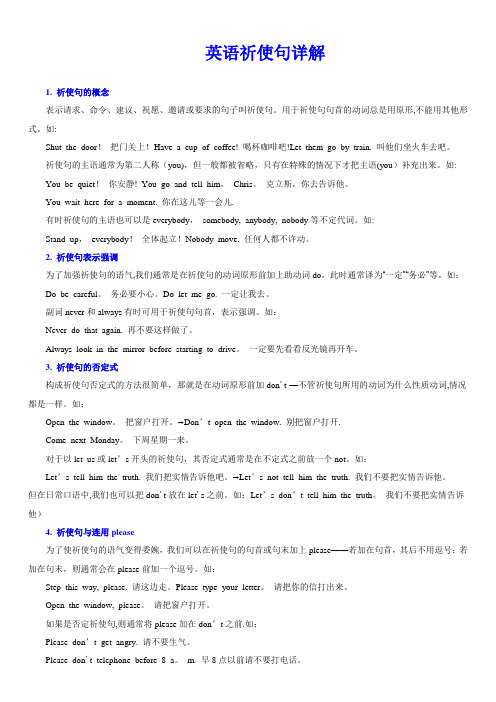
英语祈使句详解1. 祈使句的概念表示请求、命令、建议、祝愿、邀请或要求的句子叫祈使句。
用于祈使句句首的动词总是用原形,不能用其他形式。
如:Shut the door!把门关上!Have a cup of coffee! 喝杯咖啡吧!Let them go by train. 叫他们坐火车去吧。
祈使句的主语通常为第二人称(you),但一般都被省略,只有在特殊的情况下才把主语(you)补充出来。
如: You be quiet!你安静! You go and tell him,Chris。
克立斯,你去告诉他。
You wait here for a moment. 你在这儿等一会儿.有时祈使句的主语也可以是everybody,somebody, anybody, nobody等不定代词。
如:Stand up,everybody!全体起立!Nobody move. 任何人都不许动。
2. 祈使句表示强调为了加强祈使句的语气,我们通常是在祈使句的动词原形前加上助动词do,此时通常译为“一定”“务必”等。
如:Do be careful。
务必要小心。
Do let me go. 一定让我去。
副词never和always有时可用于祈使句句首,表示强调。
如:Never do that again. 再不要这样做了。
Always look in the mirror before starting to drive。
一定要先看看反光镜再开车。
3. 祈使句的否定式构成祈使句否定式的方法很简单,那就是在动词原形前加don't-—不管祈使句所用的动词为什么性质动词,情况都是一样。
如:Open the window。
把窗户打开。
→Don’t open the window. 别把窗户打开.Come next Monday。
下周星期一来。
对于以let us或let’s开头的祈使句,其否定式通常是在不定式之前放一个not。
如:Let’s tell him the truth. 我们把实情告诉他吧。
初中数学一般将来时专项语法讲解

初中数学一般将来时专项语法讲解一般将来时是表示将来某个时间要发生的动作或事件。
在初中数学中,很多时候我们需要描述将要发生的事情,使用一般将来时就尤为重要了。
I. 构成方法一般将来时由“will/shall + 动词原形”构成。
其中 shall 用得较少,will 是最主要的情态动词。
例如:I will go to school tomorrow.陈述句否定句构成如下:陈述句:I will see you tomorrow.否定句:I will not see you tomorrow.疑问句构成如下:一般疑问:Will you see me tomorrow?(肯定回答:Yes, I will.否定回答: No, I won't.)特殊疑问:What will you do tomorrow? (回答:I will go to school.)II. 动词用法将来时态只是时间状语,用途相当于陈述一件在未来某个时间会发生的事情,如“明天”,“下周”等。
* 表示未来的计划或决定:I will travel next month.* 表示意愿或承诺:I will help you with your homework.* 表示在未来一段时间内会经常发生的动作、或在未来发生的动作是一种惯:He will play basketball every morning.* 表示未来某个时间衔接发生的动作:I will wake up, and then I will brush my teeth.* 表示偶然发生的事情:There will be a party at my friend's house tomorrow.III. 练题1. 我明天早上6点起床。
2. 他下下个月去伦敦。
3. 他会在这个周末打篮球。
4. 我会帮你研究数学。
5. 当你到机场时,我会等你的。
答案:1. I will wake up at 6 tomorrow morning.2. He will go to London next month.3. He will play basketball this weekend.4. I will help you with studying mathematics.5. I will wait for you when you arrive at the airport.初中数学一般将来时是数学学习中的重要部分,希望这份语法讲解能帮助学生更好地掌握此知识点。
初中英语语法专题—名词性从句讲解
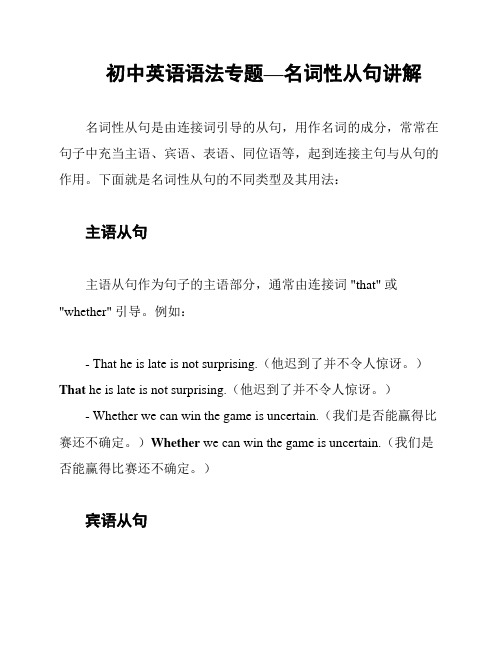
初中英语语法专题—名词性从句讲解名词性从句是由连接词引导的从句,用作名词的成分,常常在句子中充当主语、宾语、表语、同位语等,起到连接主句与从句的作用。
下面就是名词性从句的不同类型及其用法:主语从句主语从句作为句子的主语部分,通常由连接词 "that" 或"whether" 引导。
例如:- That he is late is not surprising.(他迟到了并不令人惊讶。
)That he is late is not surprising.(他迟到了并不令人惊讶。
)- Whether we can win the game is uncertain.(我们是否能赢得比赛还不确定。
)Whether we can win the game is uncertain.(我们是否能赢得比赛还不确定。
)宾语从句宾语从句作为句子的宾语,通常由连接词 "that" 或 "whether"引导。
例如:- I wonder whether he has finished his homework.(我想知道他是否完成了他的作业。
)whether he has finished his homework.(我想知道他是否完成了他的作业。
)表语从句表语从句用来补充说明主语的性质或状态,通常由连接词"that" 或 "whether" 引导。
例如:- The truth is that he is a good student.(事实是他是个好学生。
)that he is a good student.(事实是他是个好学生。
)- My concern is whether he understands the instructions.(我关心的是他是否理解了这些指示。
)whether he understands the instructions.(我关心的是他是否理解了这些指示。
初中英语语法重难点专项讲解之虚拟语气

初中英语语法重难点专项讲解之虚拟语气虚拟语气表示说话人的愿望、假设、猜测或建议,而不是事实。
虚拟语气是通过句中的谓语动词的特殊形式来表现的,因此,掌握虚拟语气中的各种谓语动词的形式变化,是掌握虚拟语气的关键。
一、虚拟语气在简单句中的用法虚拟语气用于简单句中,一般表示祝愿、命令等。
谓语动词要用原形。
二、虚拟语气在主从复合句中的用法(1)在状语从句中的用法1、条件句中的用法虚拟语气的条件句是用谓语动词的特殊形式来表现与现在、过去事实相反的情况或对将来发生的情况表示怀疑,和直陈语气条件句中的谓语动词形式以及表达的含义完全不同。
虚拟语气条件句中所用的谓语动词的过去时、过去完成时、过去将来时等,只表示不同的虚拟语气,和直陈语气的过去时、过去完成时、过去将来时等毫无关系。
现将虚拟语气的各种具体形式和用法分述如下;a. 表示与现在事实相反的情况①形式条件从句的动词形式主句的动词形式If I (we,you,he,she,it,they)+行为动词的过去式(be的过去式一般用were) I (we) should You (he,she , +动词原形或:they,it ) would所有人称+might(could)+动词原形②用法:If I had more time, I should study German.(fact:I have no more time, so I shall not study German. )If she were not so busy, she would attend the meeting this afternoon.(fact:she is very busy, so she will not attend the meeting this afternoon.)If they didn’t take physical exercises every day, they wouldn’t be so healthy.(fact: they take physical exercises every day, so they are very healthy.)b. 表示与过去誓死相反的情况①形式;条件从句的动词形式主句的动词形式If I (we,you,he,she,it,they)+had+过去分词 I (we) shouldYou (he,she , +have+过去分词或:they,it ) would所有人称+could(might)+have+过去分词②用法:I would have checked my paper again if I had had more time at yesterday’s examination.(fact:I had no more time at yesterd ay’s exam, so I didn’t check my paper again)You would have already recovered from his illness if he had seen the doctor in good time.(fact: He didn’t see the doctor in good time ,so he hasn’t recovered from his illness )c. 表示与将来事实相反的情况①形式:条件从句的动词形式主句的动词形式a. If I (we,you,he,she,it,they)+行为动词的过去式(be的过去式一般用were)通常要与一个表将来的时间的状语连用b. If (we,you,he,she,it,they)+should+动词原形c. If I (we,you,he,she,it,they)+were to+动词原形 I (we) should You would +动词原形或:he(she,it ) would they wouldI (we,you,he,she,it,they)+could(might)+动词原形②用法:If it rains tomorrow, our picnic will be put off.(The weather has been changeable these days.)If it rained tomorrow, our picnic would be put off.( The weather has beenvery good these days.)If it should rain tomorrow, our picnic would be put off.(That would be out of our expectation.)If it were to rain tomorrow, our picnic would be put off. (条件从句谓语动词用were to +动词原形,表示下雨的可能性极小。
小学英语语法专项讲解:介词

小学英语语法专项讲解:介词
导读:本文小学英语语法专项讲解:介词,仅供参考,如果觉得很不错,欢迎点评和分享。
一、介词的分类
地点(位置、范围)介词:in 在里面,on在上,in front of 在前方,under 是下方,两者之间用between ,behind 后面藏,next to 在隔壁,near 在附近与一旁,同学们用心记,各种方位用恰当。
时间介词:, at在…(时刻), in在(上/下午); on在(某日),
方式介词:by用/由/乘坐/被..., on骑(车)/徒(步), with用(材料),用(手/脚/耳/眼),
二、某些介词的用法辨析:
⑴时间或地点介词in、on、at的用法区别:表示时间时, in表示在一段时间里(在将来时句子中则表示在一段时间之后), on表示在具体的某一天或者某天的上下午等, at表示在某个时刻或者瞬间;
表示地点时, in表示在某个范围之内, on表示在某个平面上或与一个面相接触,at则表示在某个具体的场所或地点。
三、Preposition:
on, in ,in front of, between, next to, near, beside, at, behind.
表示时间:at six o’clock, at Christmas, at breakfast
on Monday on 15th July On National Day
in the evening in December in winter。
初中英语语法同位语从句讲解专项练习及答案
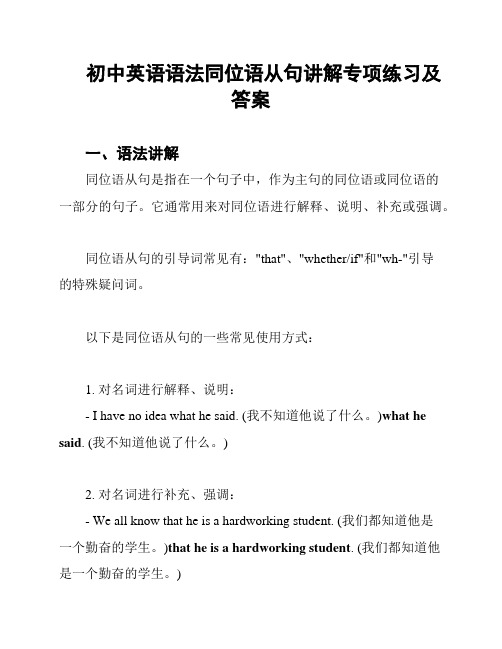
初中英语语法同位语从句讲解专项练习及答案一、语法讲解同位语从句是指在一个句子中,作为主句的同位语或同位语的一部分的句子。
它通常用来对同位语进行解释、说明、补充或强调。
同位语从句的引导词常见有:"that"、"whether/if"和"wh-"引导的特殊疑问词。
以下是同位语从句的一些常见使用方式:1. 对名词进行解释、说明:- I have no idea what he said. (我不知道他说了什么。
)what he said. (我不知道他说了什么。
)2. 对名词进行补充、强调:- We all know that he is a hardworking student. (我们都知道他是一个勤奋的学生。
)that he is a hardworking student. (我们都知道他是一个勤奋的学生。
)- The fact remains that she is guilty. (事实仍然是她有罪。
)that she is guilty. (事实仍然是她有罪。
)3. 对名词进行特殊疑问:- Could you tell me where he lives? (你能告诉我他住在哪里吗?)where he lives? (你能告诉我他住在哪里吗?)同位语从句用来修饰名词,起到进一步解释、补充或强调的作用。
二、练题及答案请根据以下句子中的同位语,填写合适的同位语从句。
1. We are all aware of the fact ____ he is a talented musician.the fact ____ he is a talented musician.- that2. The question whether ____ to attend the party or not is up to you.whether ____ to attend the party or not is up to you.- whether/if- why4. His only hope is that ____ he can pass the exam.that ____ he can pass the exam.- that5. We have no idea what ____ happened to him after the accident.what ____ happened to him after the accident.- what6. I doubt whether ____ she will be able to finish the project on time.whether ____ she will be able to finish the project on time.- whether/if7. I am curious about the place ____ they went for vacation.the place ____ they went for vacation.- where8. It is important to know what ____ happened during the meeting.what ____ happened during the meeting.- what9. His dream is that ____ he can travel around the world.that ____ he can travel around the world.- that10. The fact remains that ____ she is innocent.that ____ she is innocent.- that三、练答案1. We are all aware of the fact that he is a talented musician.the fact that he is a talented musician.2. The question whether to attend the party or not is up toyou.whether to attend the party or not is up to you.4. His only hope is that he can pass the exam.that he can pass the exam.5. We have no idea what happened to him after the accident.what happened to him after the accident.6. I doubt whether she will be able to finish the project ontime.whether she will be able to finish the project on time.7. I am curious about the place where they went for vacation.the place where they went for vacation.8. It is important to know what happened during the meeting.what happened during the meeting.9. His dream is that he can travel around the world.that he can travel around the world.10. The fact remains that she is innocent.that she is innocent.以上是初中英语语法同位语从句的讲解及练习题及答案。
英语语法反义疑问句专项讲解(终审稿)

英语语法反义疑问句专项讲解TPMK standardization office【 TPMK5AB- TPMK08- TPMK2C- TPMK18】反义疑问句一、反义疑问句又叫附加疑问句。
反义疑问句由两部分组成:前一部分是一个陈述句,后一部分是一个简短的疑问句,两部分的人称时态应保持一致。
1.陈述部分为肯定式 + 疑问部分为否定式(如果陈述部分的否定词带有否定前缀,那么,该陈述部分作肯定处理,附加疑问部分一般仍用否定形式)e.g. She was ill yesterday, wasn’t sheTom dislikes the book, doesn’t he2.陈述部分为否定式 + 疑问部分为肯定式(陈述部分用 no, nothing, nobody, never, few, seldom, hardly, rarely, little等否定或半否定含义的词时,疑问部分用肯定式。
)e.g. He can’t ride a bike, can heSome plants never blown (开花), do they二、附加疑问句(一)主语的选择1.陈述部分的主语是I,疑问部分要用 aren't I.I’m as tall as your sister, aren't I?注:当陈述部分的主语是I,而句子又用来征询对方的意见时,附加疑问句中的主语用you。
如:I find English very interesting, don’t youI don’t like that film, do you2.当陈述部分的主语是everybody, everyone, someone, nobody, no one, somebody等合成代词时,附加疑问句中的主语通常用they,亦可用he,如:Somebody phoned while I was out, didn’t theyEveryone enjoyed the party, didn’t theyNobody wants to go there, does he3.当陈述部分的主语是不定代词everything, nothing, anything, something 时,附加疑问句中的主语一般用it,如:Everything seems all right now, doesn’t itNothing is kept in good order, is itSomething must be done to stop pollution, isn’t it4.当陈述部分的主语是指示代词this, that或these, those时,附加疑问句中的主语分别用it和they,如:This is important, isn’t itThat isn’t correct, is itThese are your friends Tom and Jack, aren’t they5.如果陈述部分是以代词one作主语,附加疑问句中的主语在正式场合用one,非正式场合下可以用you或he,如:One can’t be too careful, can one或can youOne should do his duty, shouldn’t he6.当陈述句为there be结构时,附加疑问句中的主语也用there。
中考英语语法专项复习讲解及训练 主谓一致(含答案)
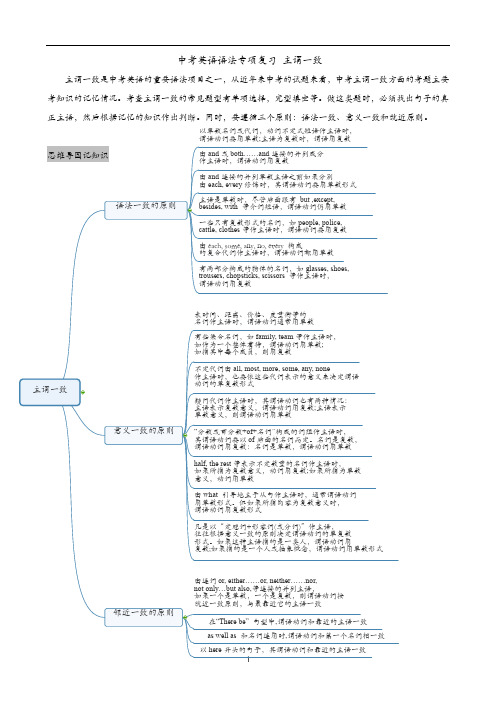
中考英语语法专项复习主谓一致主谓一致是中考英语的重要语法项目之一,从近年来中考的试题来看,中考主谓一致方面的考题主要考知识的记忆情况。
考查主谓一致的常见题型有单项选择,完型填空等。
做这类题时,必须找出句子的真正主语,然后根据记忆的知识作出判断。
同时,要遵循三个原则:语法一致、意义一致和就近原则。
以单数名词或代词,动词不定式短语作主语时,谓语动词要用单数;主语为复数时,谓语用复数主谓一致概述:谓语受主语支配,须和主语在人称和数上保持一致,这叫做主谓一致。
主谓一致一般遵循三条原则:语法一致原则,意义一致原则和就近一致原则。
1. 语法一致的原则(1)以单数名词或代词,动词不定式短语作主语时,谓语动词要用单数;主语为复数时,谓语用复数,例如:He goes to school early every morning.The children are playing outside.To work hard is necessary for a student.(2)由and或both……and连接的并列成分作主语时,谓语动词用复数。
例如:Both he and I are right.Mr Black and Mrs Black have a son called Tom.但并列主语如果指的是同一人,同一事物或同一概念,谓语动词用单数。
例如:His teacher and friend is a beautiful girl.The poet and writer has come.(3)由and连接的并列单数主语之前如果分别由each, every修饰时,其谓语动词要用单数形式。
例如:In our country every boy and every girl has the right to receive education.Each man and each woman is asked to help.(4)主语是单数时,尽管后面跟有but ,except, besides, with 等介词短语,谓语动词仍用单数。
中考英语语法填空专项讲解+习题+答案
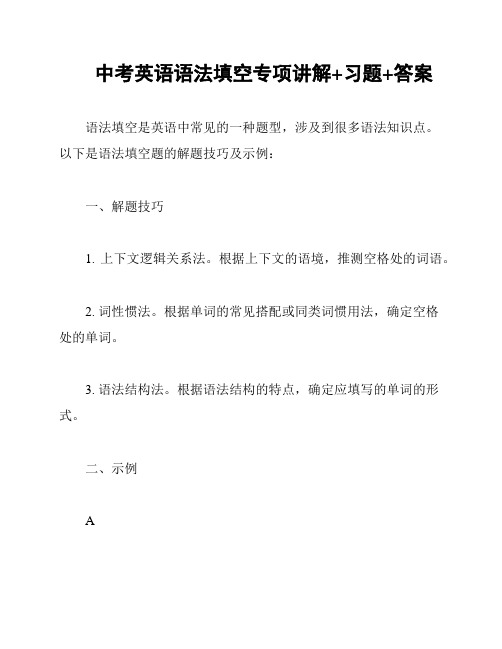
中考英语语法填空专项讲解+习题+答案语法填空是英语中常见的一种题型,涉及到很多语法知识点。
以下是语法填空题的解题技巧及示例:一、解题技巧1. 上下文逻辑关系法。
根据上下文的语境,推测空格处的词语。
2. 词性惯法。
根据单词的常见搭配或同类词惯用法,确定空格处的单词。
3. 语法结构法。
根据语法结构的特点,确定应填写的单词的形式。
二、示例AGrandma Moses began painting in earnest, at the age of seventy-six. She had always enjoyed needlework (1) __________ a pastime, but when she was no longer able to hold (2) __________ a needle, she turned to painting.1. as2. ontoB1. where2. andCThe spelling of some words in English is difficult (1) __________ they have been taken from various other languages. For example, there are many words in French which contain accents and (2) __________ are simply impossible to spell unless you learn the rules.1. because2. which答案:A. 1. as, 2. ontoB. 1. where, 2. andC. 1. because, 2. which以上是语法填空专项讲解及习题答案,学生可以通过不断练习,提高语法填空答题技能,取得更好的成绩。
小学英语语法专项讲解-名词

小学英语语法专项讲解-名词一、定义名词是表示人或事物名称的词。
它既可以表示具体的东西,也可以是表示抽象的东西。
二、分类1. 名词可以根据意义分为普通名词和专有名词如:John is a studentstudent是普通名词,John是专有名词普通名词前可以用不定冠词a/an, 定冠词the 或不加冠词,专有名词前一般不加冠词,专有名词的首字母要大写。
2. 普通名词又可以分为个体名词、集体名词、物质名词和抽象名词,其中个体名词与集体名词是可数名词,物质名词和抽象名称是不可数名词。
3. 专有名词专有名词是表示人名、地名、团体、机构、组织等的专有名词,多为独一无二的事物。
三、名词的数1、名词分为可数名词和不可数名词。
可数名词——可以数的名词不可数名词——数不清(没有复数)Drink?milk tea water orange juice coke coffee porridgeFood?rice bread meat fish fruit cake dumplings2、可数名词与不定冠词a(an)连用有数数形式,不可数名词不能与不定冠词a(an)连用,没有复数形式many+可数名词复数much/a little+不可数名词some, any , a lot of (lots of) 两者都可以修饰。
3、可数名词可以直接用数词来修饰不可数名词数词 +量词 +of + 名词对可数名词的数量提问用How many对不可数名词的数量提问用 How much4、不可数名词的量有以下两种表示方法:1) some, much ,a little ,a lot of ,a bit of , plenty of 用等表示多少。
注意既可以与可数名词复数,又可以与不可数名词连用的有:plenty of ,some ,a lot of ,lots of ,most of 等。
如There is much water in the bottle .瓶中有很多水。
小学英语语法专项练习-动词讲解及练习题

小学英语语法专项练习-动词讲解及练习题一、动词的概念动词是表示人、事物的动作、状态或存在的词,是英语句子中最核心的部分。
二、动词的分类1. 及物动词:需要加宾语才能构成句子的动词,例如:write、eat等。
2. 不及物动词:不需要加宾语也可以构成句子的动词,例如:laugh、sit等。
3. 助动词:辅助主要动词构成各种时态、语态和否定式,例如:be、do等。
三、动词时态动词时态表示动作发生的时间,常用的动词时态有以下几种:1. 一般现在时:表示现在正在发生的事情或经常性的动作。
2. 一般过去时:表示过去发生的动作或状态。
3. 一般将来时:表示将要发生的动作或状态。
4. 现在进行时:表示现在正在进行的动作或状态。
5. 过去进行时:表示过去某个时刻正在进行的动作或状态。
6. 将来进行时:表示将来某个时刻正在进行的动作或状态。
四、动词的练题1. 用所给动词的正确形式填空:1) He often ____(play) football with his friends after school.2) My father ____(be) a doctor when he was young.3) They ____(visit) the museum tomorrow morning.4) She ____(watch) TV now.2. 根据括号内的提示写出动词正确的形式:1) He usually ____(drink) milk in the morning. (一般现在时)2) We ____(cook) dinner at six o'clock last night. (一般过去时)3) Tomorrow we ____(go) to the park to have a picnic. (一般将来时)4) Look! The boy ____(swim) in the river. (现在进行时)以上是小学英语语法专项练习-动词讲解及练习题,希望有所帮助!。
非谓语动词专项讲解
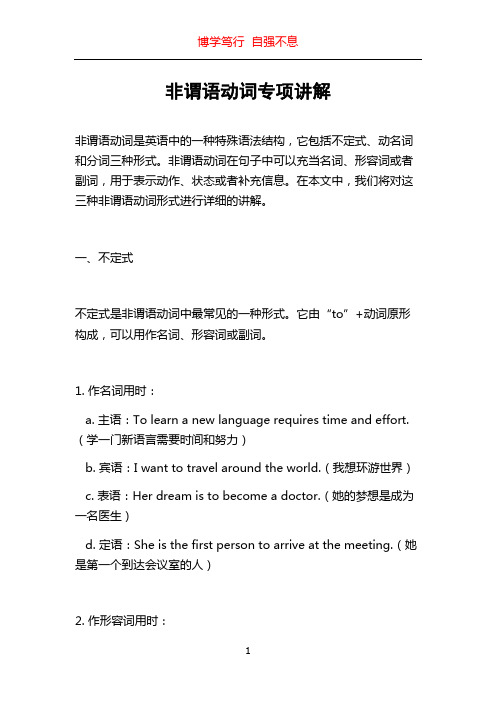
非谓语动词专项讲解非谓语动词是英语中的一种特殊语法结构,它包括不定式、动名词和分词三种形式。
非谓语动词在句子中可以充当名词、形容词或者副词,用于表示动作、状态或者补充信息。
在本文中,我们将对这三种非谓语动词形式进行详细的讲解。
一、不定式不定式是非谓语动词中最常见的一种形式。
它由“to”+动词原形构成,可以用作名词、形容词或副词。
1. 作名词用时:a. 主语:To learn a new language requires time and effort.(学一门新语言需要时间和努力)b. 宾语:I want to travel around the world.(我想环游世界)c. 表语:Her dream is to become a doctor.(她的梦想是成为一名医生)d. 定语:She is the first person to arrive at the meeting.(她是第一个到达会议室的人)2. 作形容词用时:a. The book to read is on the shelf.(要读的书在书架上)b. This is an easy task to finish.(这是一个容易完成的任务)3. 作副词用时:a. He studies hard to improve his grades.(他努力学习以提高成绩)b. I ran fast to catch the bus.(我跑得快以赶上公交车)二、动名词动名词是非谓语动词的另一种形式,它由动词+ing构成,可以作名词、形容词或副词。
1. 作名词用时:a. Smoking is harmful to health.(吸烟对健康有害)b. Swimming is my favorite sport.(游泳是我最喜欢的运动)2. 作形容词用时:a. The running water is very clear.(流动的水非常清澈)b. I saw a man dancing in the park.(我看见一个在公园里跳舞的人)3. 作副词用时:a. She solved the math problem by using a calculator.(她用计算器解决了这个数学问题)b. He answered the question by nodding his head.(他点头回答了这个问题)三、分词分词是非谓语动词的第三种形式,分为现在分词(-ing形式)和过去分词(-ed, -en, -d, -t形式)。
语法专项现在进行时表示将来讲解和练习
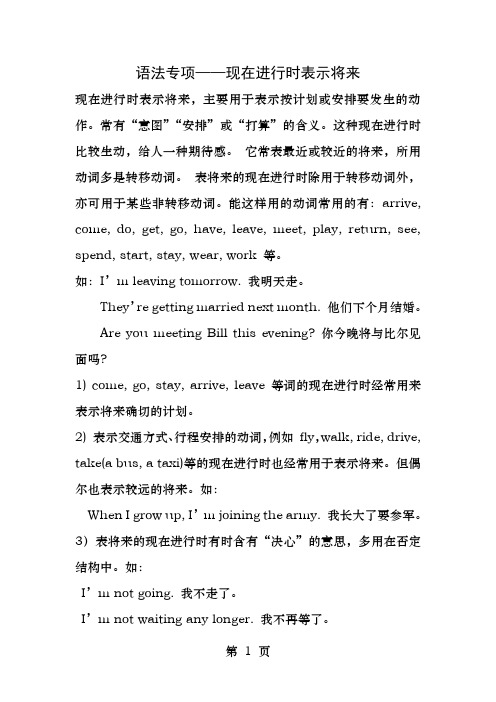
语法专项——现在进行时表示将来现在进行时表示将来,主要用于表示按计划或安排要发生的动作。
常有“意图”“安排”或“打算”的含义。
这种现在进行时比较生动,给人一种期待感。
它常表最近或较近的将来,所用动词多是转移动词。
表将来的现在进行时除用于转移动词外,亦可用于某些非转移动词。
能这样用的动词常用的有:arrive, come, do, get, go, have, leave, meet, play, return, see, spend, start, stay, wear, work 等。
如:I’m leaving tomorrow. 我明天走。
They’re getting married next month. 他们下个月结婚。
Are you meeting Bill this evening? 你今晚将与比尔见面吗?1) come, go, stay, arrive, leave 等词的现在进行时经常用来表示将来确切的计划。
2) 表示交通方式、行程安排的动词,例如fly,walk, ride, drive, take(a bus, a taxi)等的现在进行时也经常用于表示将来。
但偶尔也表示较远的将来。
如:When I grow up, I’m joining the army. 我长大了要参军。
3)表将来的现在进行时有时含有“决心”的意思,多用在否定结构中。
如:I’m not going. 我不走了。
I’m not waiting any longer. 我不再等了。
有时也用在肯定结构中。
如:I’m backing out. 我要打退堂鼓了。
4)用这种现在进行时与对方讲话时可变成命令,不过语气比较温与。
如:You are staying. 你留下吧。
Don’t forget: you are taking part too. 不要忘记:你也要参加。
5)现在进行时也可在时间、条件或原因状语从句中表示将来。
- 1、下载文档前请自行甄别文档内容的完整性,平台不提供额外的编辑、内容补充、找答案等附加服务。
- 2、"仅部分预览"的文档,不可在线预览部分如存在完整性等问题,可反馈申请退款(可完整预览的文档不适用该条件!)。
- 3、如文档侵犯您的权益,请联系客服反馈,我们会尽快为您处理(人工客服工作时间:9:00-18:30)。
九年级英语总复习语法部分一、名词一.定义:表示人或事物名称的词叫做名词。
二. 分类:(1)有两大类:专有名词和普通名词。
专有名词指人名、地名、组织机构以及节日名称,第一个字母必须大写。
(2)普通名词分为可数名词和不可数名词。
(3)可数名词分为个体名词(表示某类人或东西中的个体,dog, girl等和集体名词(由若干个体组成的整体:如group群,组;people人;class班;team队;family 家庭和police警察等,且police 和people单数与复数同形,people, police作主语,谓语动词用复数。
(4)不可数名词分为抽象名词和物质名词,抽象名词表示动作,状态,品质,感情等抽象概念。
如:love爱, silence安静, success成功。
物质名词用来指无法分为个体的物质的名词。
如:water, rain, wool等三.可数名词的用法:有单、复数之分,表示一个用单数,表示两个或两个以上复数。
(1)单数名词的用法:其前一般加a, an, the, this, that等词表示一个,如:a useful book; an umbrella(2)名词的复数:有规则和不规则之分。
1) 规则名词变复数的方法见时态表。
2)不规则名词的单复数:单数复数单数复数单数复数sheep sheep foot feet human humansdeer deer tooth teeth German Germans Chinese Chinese man men child children Japanese Japanese woman womenpeople peoplepolice police四.其他词(代词)的复数形式变化如下:单数复数单数复数单数复数this these 宾格him, her, it them 形容词性物主代词histheirthat those you you her is / am are my our its was were your yourhas have me us名词性物主代词histheirs主格I we mine ours hers he,she,it they yours yours its五.合成名词的复数形式:(1)一般将主体名词变为复数。
如:apple tree→apple trees; boy student→boy students(2)由man / woman +名词构成的合成词的复数要将两者都变为复数。
如:man teacher→men teachers; woman doctor → wome n doctors(3)名词+ man / woman构成的复合名词的复数,把man变为men; 把woman变为women.如:Frenchman → Frenchmen ; policewoman →policewomen(但: German→ Germans )(4)有些词只能作复数,如: trousers裤子; clothes衣服; glasses眼镜; stairs楼梯(5)可数名词量的表达:(1)名词前加few; a few; many; several; a lot of ; lots of ; some; any; a (great) number of ; large; numbers of ; thousands of, 基数词等.如:lots of people; several books(2)数词(2以上)+可数名词复数如:five apples(3) 数词+ 量词(s)+of +可数名词复数如:a box of apples; two boxes of apples六. 不可数名词的用法:(1)不可数名词没有复数形式,其前不能加a ; an,修饰可数名词的形容词和数词不能与其连用。
如:不说a bread; five bread或a few bread可以说a piece of bread(2)不可数名词量的表达:①可用much; a little; little; a lot of ; lots of ; some; any; plenty of ; most of等表示数量②用“a / two … + 量词(s) + of + 不可数名词”表示。
单位词常规的有cup(杯); glass(玻璃杯); piece(片、块、张); bag(袋); box(箱、盒子); kilo(公斤); pair(双、对); bottle (瓶); bowl(碗)等,如:a cup of tea一杯茶; two glasses of milk两杯牛奶七.名词所有格:名词+’s表示所有关系,这种形式称为名词所有格,意为“……的”如:LiLei’s father; Jim’s bag (1)名词所有格的构成:1)在名词词尾加(’s)用于有生命的名词所有格①表示共有的东西时,只在最后一个名词后加’s ,如:This is Jenrry and Susan’s school.②表示各个所有,需要在每个名字后加’s,如:There are Jenrry’s and Susan’s school.③以S结尾的复数名词只加’ . 如:Teachers’Day教师节; International Nurses’Day护士节④不以S结尾的复数名词加’s,如:Children’s Day儿童节; Women’s Day妇女节2)“名词+ of +名词”用于无生命的名词所有格。
意为"……的……",如:the name of the book书名; the photo of the family全家照注:表示时间的名词,如:国家、城市等地方名词可用’s表示所有格。
如:today’s newspaper今天的报纸; ten minutes’ walk十分钟的路(2)名词的双重所有格:由数量词a; some,two, no, any, a few等+ 名词+ of + 名词所有格或名词性物主代词构成,表示众多中的一个或一些.如:a friend of my sister’s 我姐姐的一个朋友 a friend of mine我的一个朋友some books of my teacher’s 我的老师的一些书 a brother of hers他的一个弟弟八.常见的不可数名词有:tea茶, water水, orange桔汁, milk牛奶, juice果汁, coffee咖啡, oil油, rice大米, bread面包, meat肉, pork猪肉, beef牛肉, fish鱼, news新闻, sugar糖, honey蜂蜜, information信息, fruit 水果, work工作, homework作业, housework家务, paper纸, rain雨, snow雪, ice冰, wind风, time (时间), money钱, room空间,silk丝绸, cotton棉花, knowledge知识, weather天气, food食物, fun乐趣, metal材料, wood木头, advice建议,及语言名词English英语, Japanese日语, Chinese汉语, French法语, Germany德语等。
二、冠词一、冠词用在名词前,说明名词所指定的人或事物。
二、冠词的种类:冠词分为不定冠词和定冠词两种形式。
不定冠词为"a, an";定冠词“the”。
三、不定冠词的用法:1.不定冠词a,an只用于单数可数名词前,表示“一个”。
a用在以辅音开头词前,如:a useful book, a university, a car…; an用在以元音开头的词前。
如:①an hour; an umbrella; an animal/ orange/ egg/ apple/ English book/ old man( woman)等。
②表示一个a, i , e , o, f, h, l , m , n , r , s , x 这些字母时用an,如:There is an "r" in the word "car".2.用于表示长度、时间、速度、价格等意义的词语之前,表示“每一”的意思。
如:We have three meals a day.我们每天吃三顿饭。
The car can run 200 kilometers an hour.这部车每小时能跑200公里。
3.用于单数名词前通常表示一类人或事物(以其中的一个代表一类),如:A dog is our good friend. 狗是我们的好朋友。
4.用一第一次提到的可数名词单数之前(此类名词不表示特定的人或物)。
如:She works in a bank. 她在一家银行工作。
5.表示数量,有“一”的意思,但数的概念没有one强烈,可以代替one。
如:It is a foot long, an inch thick. 它有一英尺长,一英尺厚。
6.用于序数词前表示“再一…”“又一…”的意思。
如:The man tried two time, he wanted a third time.那人试了两次,他想再试一次。
7.用于词组中,且是这一词组中不可缺少的部分。
如:a bit= a little一点=;a lot of 许多;in a hurry匆忙地;go for a walk去散步;make a living 谋生;as a result of 结果;in a low voice 低声地;once upon a time从前;have a good time玩得高兴;;have a cold休息一下;a number of 许多;大量;with a smile微笑地;a few少数;for a long time长时间;a moment later/ aftera while一会儿之后; have a cold感冒等。
四、定冠词the 的用法:1.用于名词前表示特指的人或事物。
如:The man is a doctor.注意:可数名词表示泛指概念时,一般采用零冠词(即不用冠词的形式)。
复数形式或不用冠词的单数形式。
表示特指概念时,前面要有定冠词。
如:Bogs will be boys.2.对于前面已经提到的人或事物在第二次提到时要用来表示特指。
如:I have a bike and I like the bike very much.3.用在说话人、听话人双方都知道的特定的人或事物前。
